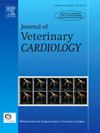Valvular mitral stenosis in adult cats: knowledge gained from the clinical and pathological workup of 18 cases
IF 1.3
2区 农林科学
Q2 VETERINARY SCIENCES
引用次数: 0
Abstract
Introduction/objectives
Feline valvular mitral stenosis (VMS) is uncommonly reported. The aim of this study was to describe diagnostic and clinicopathological characteristics of VMS in adult cats.
Animals, Materials and Methods
Eighteen client-owned cats were included in this study. A retrospective observational study. Clinical records were searched based on echocardiography. Data regarding clinical, laboratory, echocardiographic findings, outcome, and, in four cats, gross postmortem images of the heart were reviewed, and histological examinations performed.
Results
Most cats were non-pedigree (11/18), with a median age of 13.2 years. Congestive heart failure was common (15/18). Three cats had hypertrophic cardiomyopathy phenotype, including one with transient myocardial thickening. Concomitant hyperthyroidism (9/18) was frequent. In one cat, echocardiography performed one year earlier did not show any changes. Upon echocardiography, all 18 cats had characteristic hockey-stick appearance of the anterior leaflet and narrow turbulent diastolic flow across the mitral valve. Twelve cats had fused diastolic transmitral waves, with a median velocity of 0.54 m/s (0.71–3.24 m/s). The remaining six had a median peak velocity of the early and late-diastolic transmitral waves of 1.3 m/s (0.95–2.8 m/s) and 0.99 m/s (0.65–2.05 m/s), respectively. Eleven cats had died, 10 of cardiac death (median survival time: 366 days). Macroscopically, the mitral valve leaflets appeared thickened and distorted, and the surrounded ventricular endocardium thickened. Histology revealed marked endocardial fibrosis of the mitral valve and surrounding ventricular endocardium, dominated by type I collagen.
Conclusions
The most striking finding is the documented acquirement of VMS in one cat, while the acquired nature of the lesion could not be confirmed in the other cases. The pathological findings are compatible with a chronic remodeling process that results in marked endocardial fibrosis in four cats.
成年猫二尖瓣狭窄:从18例临床和病理检查中获得的知识
简介/目的猫二尖瓣狭窄(VMS)是罕见的报道。本研究的目的是描述成年猫VMS的诊断和临床病理特征。动物、材料和方法本研究共纳入18只客户养猫。回顾性观察性研究。根据超声心动图检索临床记录。我们回顾了4只猫的临床、实验室、超声心动图结果、结果以及大体死后心脏图像,并进行了组织学检查。结果大多数猫是非纯种猫(11/18),中位年龄为13.2岁。充血性心力衰竭较为常见(15/18)。三只猫有肥厚型心肌病表型,其中一只有短暂性心肌增厚。合并甲状腺功能亢进(9/18)较为常见。在一只猫中,一年前进行的超声心动图没有显示任何变化。超声心动图显示,所有18只猫的前小叶呈典型的曲棍球棒状,二尖瓣舒张血流狭窄。12只猫的舒张透射波融合,平均速度为0.54 m/s (0.71-3.24 m/s)。其余6例舒张早期和晚期透射波的中位峰值速度分别为1.3 m/s (0.95 ~ 2.8 m/s)和0.99 m/s (0.65 ~ 2.05 m/s)。11只猫死亡,10只心源性死亡(中位生存时间:366天)。宏观上,二尖瓣小叶增厚变形,周围心室心内膜增厚。组织学显示二尖瓣及周围心室心内膜明显纤维化,以I型胶原为主。结论最显著的发现是在1只猫中记录了VMS的获得性,而在其他病例中无法确认病变的获得性。病理结果与导致4只猫显著心内膜纤维化的慢性重塑过程相一致。
本文章由计算机程序翻译,如有差异,请以英文原文为准。
求助全文
约1分钟内获得全文
求助全文
来源期刊

Journal of Veterinary Cardiology
VETERINARY SCIENCES-
CiteScore
2.50
自引率
25.00%
发文量
66
审稿时长
154 days
期刊介绍:
The mission of the Journal of Veterinary Cardiology is to publish peer-reviewed reports of the highest quality that promote greater understanding of cardiovascular disease, and enhance the health and well being of animals and humans. The Journal of Veterinary Cardiology publishes original contributions involving research and clinical practice that include prospective and retrospective studies, clinical trials, epidemiology, observational studies, and advances in applied and basic research.
The Journal invites submission of original manuscripts. Specific content areas of interest include heart failure, arrhythmias, congenital heart disease, cardiovascular medicine, surgery, hypertension, health outcomes research, diagnostic imaging, interventional techniques, genetics, molecular cardiology, and cardiovascular pathology, pharmacology, and toxicology.
 求助内容:
求助内容: 应助结果提醒方式:
应助结果提醒方式:


